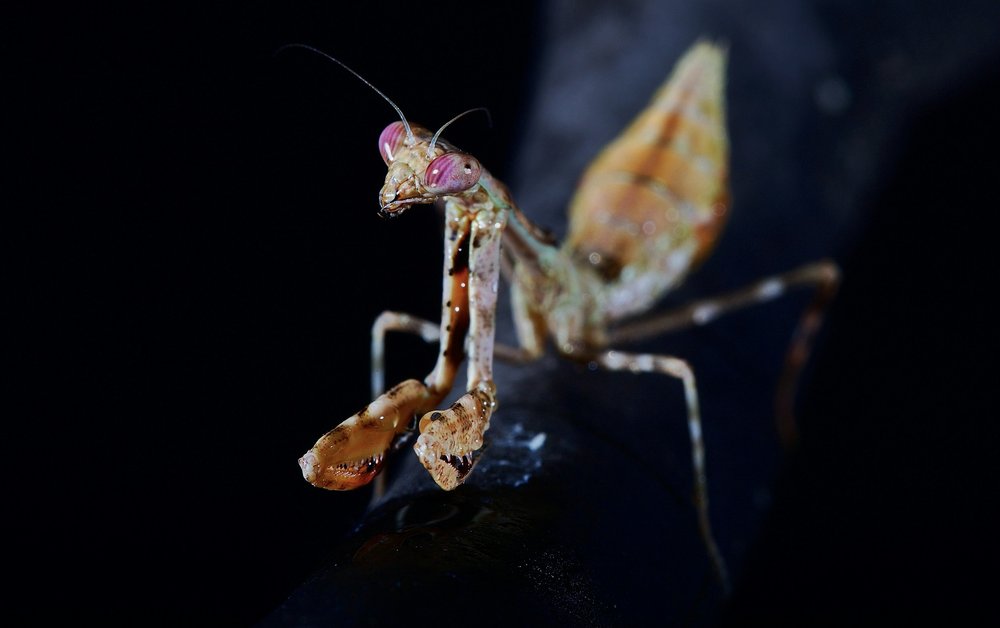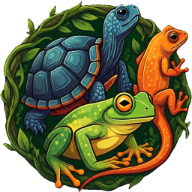
Mantodae
Introduction
The praying mantis (Mantodae) is an insect species found all over the world. They are primarily located in warmer regions but can also be found in deserts. The praying mantis gets its name from its 'praying' posture. They can vary in size from 2.5 cm to about 15 cm. A praying mantis does not have a long lifespan; males typically live shorter than females. When a mantis reaches adulthood, the male lives for about 2-4 months, while the female can live for 6-8 months, depending on the species.
Enclosure
The mantis is solitary. They are quite cannibalistic and will eat one another. There are a few species that can possibly be kept together, such as Phyllocrania paradoxa or Gongylus gongylodus, provided that the mantises are well-fed and the terrarium is large enough. The terrarium for the mantis should be twice as wide as the adult length of the species and three times as tall. Do not provide the mantis with an overly large terrarium, as this can result in difficulty finding food. Good ventilation is very important.
For substrate, you can use cocopeat, for example. Plants can be placed in the terrarium as well. Be sure to include branches or other materials for them to climb on. It is important that the terrarium has a mesh top since they need a good grip to molt. Always leave space at the top for them to molt; obstacles can lead to malformations.
Temperature & Humidity
The appropriate temperature range for most reptile species should generally fall between 20-25 degrees Celsius during the daylight hours, while at night, it is advisable to keep it slightly lower, ideally between 18-20 degrees Celsius. To ensure optimal living conditions, humidity levels should be carefully maintained within the range of 60-80%. It is important to note that not all reptile species possess the same specific requirements when it comes to temperature and humidity, so individual care must be taken. Additionally, these reptiles require a consistent day-night cycle, ideally comprising approximately 10-12 hours of light each day to support their natural biological rhythms.
Food & supplements
Mantis often prefer flying foods such as fruit flies, curly flies, or house flies. Other food items can also be provided, such as grasshoppers, wax worms/wax worm larvae, dubia roaches, or oven fish. Flying food remains the best and safest option to offer. Insects like grasshoppers can bite the mantis with their jaws. Crickets can cause blockages and are not a good food option. When feeding the mantis, pay attention to the structure of the body; the accompanying photo serves as a useful guideline for that purpose. The abdomen indicates whether the mantis can be fed or not. A mantis that receives too much food has a chance of bursting open.
Care & Handling
mantis are primarily display animals and not pets meant for handling. They are manageable but can run very quickly. Be sure to keep a close eye on them so they don't escape. Never handle a mantis right after molting; wait at least 48 hours to allow the mantis to harden properly. Adult animals have wings with which they can fly. Males fly more often than females, typically using their wings when they perceive a threat, making themselves appear larger.
Mist the terrarium every 2-3 days. Ensure that small water droplets are present on the windows, and you can also lightly mist the mantis. It is important to keep the terrarium clean. The substrate must be free of waste, and uneaten food items should be removed.
Conclusion & Difficulty
Mantidae are not very hard to care for, as long as you make sure that the enclosure is properly set up and that the environmental parameters are suitable for their well-being. You have to be careful with their diet and ensure that you know what to expect, especially considering the significant differences between the sexes that can impact their care and behavior.
Difficulty 2 out of 5.
